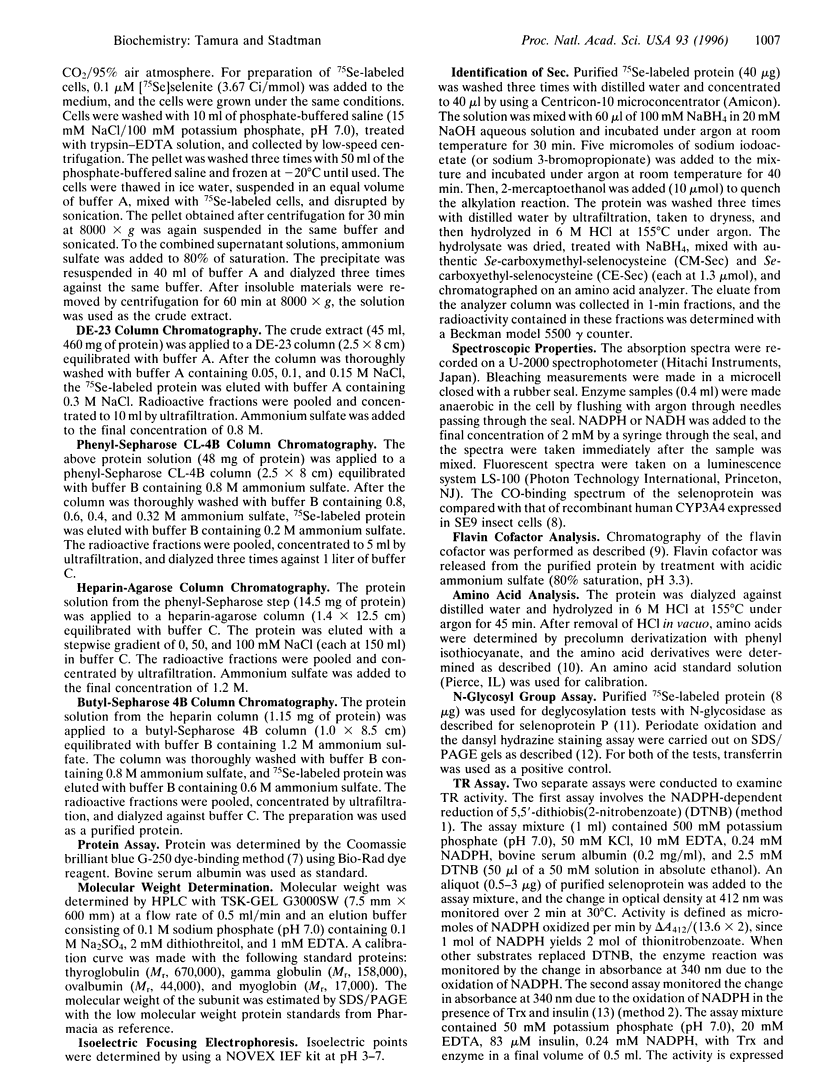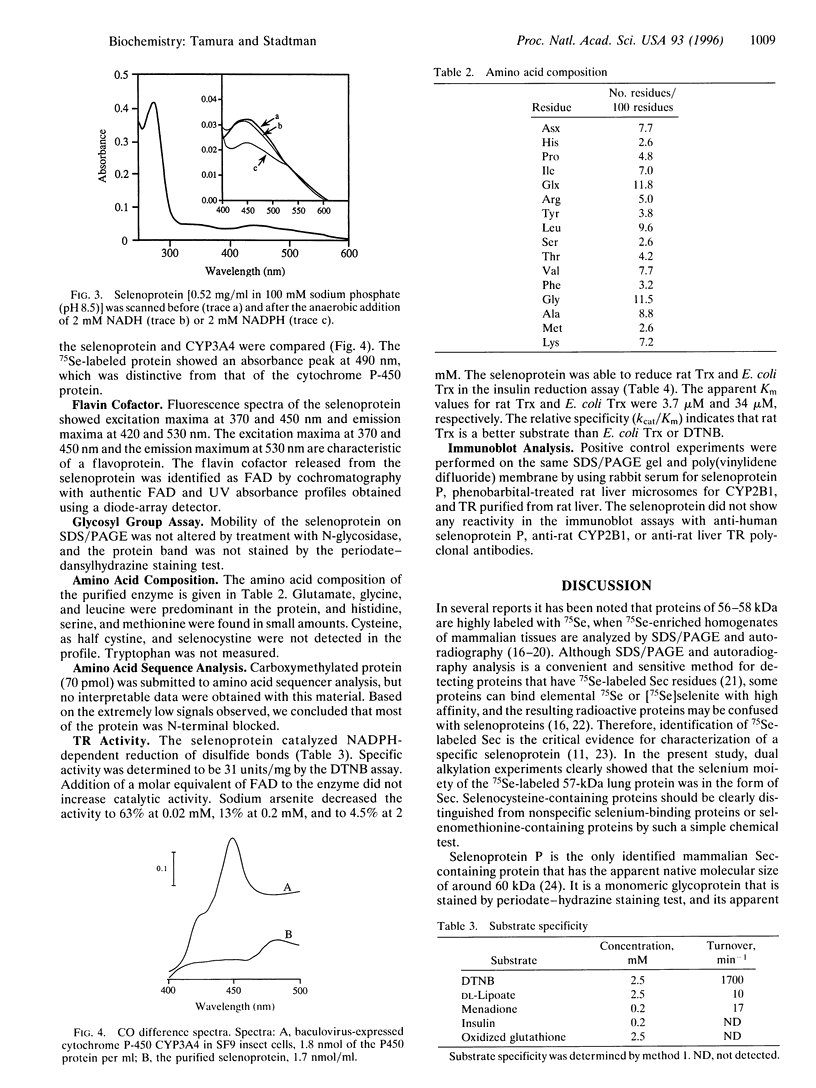Abstract
We report the isolation and characterization of a new selenoprotein from a human lung adenocarcinoma cell line, NCI-H441. Cells were grown in RPMI-1640 medium containing 10% (vol/vol) fetal bovine serum and 0.1 microM [75Se]selenite. A 75Se-labeled protein was isolated from sonic extracts of the cells by chromatography on DE-23, phenyl-Sepharose, heparin-agarose, and butyl-Sepharose. The protein, a homodimer of 57-kDa subunits, was shown to contain selenium in the form of selenocysteine; hydrolysis of the protein alkylated with either iodoacetate or 3-bromopropionate yielded Se-carboxymethyl-selenocysteine or Se-carboxyethyl-selenocysteine, respectively. The selenoprotein showed two isoelectric points at pH 5.2 and pH 5.3. It was distinguished from selenoprotein P by N-glycosidase assay and by the periodate-dansylhydrazine test, which indicated no detectable amounts of glycosyl groups on the protein. The selenoprotein contains FAD as a prosthetic group and catalyzes NADPH-dependent reduction of 5,5'-dithiobis(2-nitrobenzoic acid) (DTNB), and reduction of insulin in the presence of thioredoxin (Trx). The specific activity was determined to be 31 units/mg by DTNB assay. Apparent Km values for DTNB, Escherichia coli Trx, and rat Trx were 116, 34, and 3.7 microM, respectively. DTNB reduction was inhibited by 0.2 mM arsenite. Although the subunit composition and catalytic properties are similar to those of mammalian thioredoxin reductase (TR), the human lung selenoprotein failed to react with anti-rat liver TR polyclonal antibody in immunoblot assays. The selenocysteine-containing TR from the adenocarcinoma cells may be a variant form distinct from rat liver TR.
Full text
PDF





Images in this article
Selected References
These references are in PubMed. This may not be the complete list of references from this article.
- Bansal M. P., Oborn C. J., Danielson K. G., Medina D. Evidence for two selenium-binding proteins distinct from glutathione peroxidase in mouse liver. Carcinogenesis. 1989 Mar;10(3):541–546. doi: 10.1093/carcin/10.3.541. [DOI] [PubMed] [Google Scholar]
- Behn D., Weiss-Nowak C., Kalcklösch M., Westphal C., Gessner H., Kyriakopoulos A. Studies on the distribution and characteristics of new mammalian selenium-containing proteins. Analyst. 1995 Mar;120(3):823–825. doi: 10.1039/an9952000823. [DOI] [PubMed] [Google Scholar]
- Berry M. J., Banu L., Larsen P. R. Type I iodothyronine deiodinase is a selenocysteine-containing enzyme. Nature. 1991 Jan 31;349(6308):438–440. doi: 10.1038/349438a0. [DOI] [PubMed] [Google Scholar]
- Berry M. J., Harney J. W., Ohama T., Hatfield D. L. Selenocysteine insertion or termination: factors affecting UGA codon fate and complementary anticodon:codon mutations. Nucleic Acids Res. 1994 Sep 11;22(18):3753–3759. doi: 10.1093/nar/22.18.3753. [DOI] [PMC free article] [PubMed] [Google Scholar]
- Bradford M. M. A rapid and sensitive method for the quantitation of microgram quantities of protein utilizing the principle of protein-dye binding. Anal Biochem. 1976 May 7;72:248–254. doi: 10.1016/0003-2697(76)90527-3. [DOI] [PubMed] [Google Scholar]
- Burk R. F., Hill K. E., Awad J. A., Morrow J. D., Kato T., Cockell K. A., Lyons P. R. Pathogenesis of diquat-induced liver necrosis in selenium-deficient rats: assessment of the roles of lipid peroxidation and selenoprotein P. Hepatology. 1995 Feb;21(2):561–569. [PubMed] [Google Scholar]
- Burk R. F., Hill K. E. Selenoprotein P. A selenium-rich extracellular glycoprotein. J Nutr. 1994 Oct;124(10):1891–1897. doi: 10.1093/jn/124.10.1891. [DOI] [PubMed] [Google Scholar]
- Buters J. T., Korzekwa K. R., Kunze K. L., Omata Y., Hardwick J. P., Gonzalez F. J. cDNA-directed expression of human cytochrome P450 CYP3A4 using baculovirus. Drug Metab Dispos. 1994 Sep-Oct;22(5):688–692. [PubMed] [Google Scholar]
- Casadaban M. J., Chou J., Cohen S. N. In vitro gene fusions that join an enzymatically active beta-galactosidase segment to amino-terminal fragments of exogenous proteins: Escherichia coli plasmid vectors for the detection and cloning of translational initiation signals. J Bacteriol. 1980 Aug;143(2):971–980. doi: 10.1128/jb.143.2.971-980.1980. [DOI] [PMC free article] [PubMed] [Google Scholar]
- Chen C. C., McCall B. L., Moore E. C. Purification of thioredoxin reductase from the Novikoff rat tumor. Prep Biochem. 1977;7(2):165–177. doi: 10.1080/00327487708061633. [DOI] [PubMed] [Google Scholar]
- Chen C. C., Moore E. C., McCall B. L. Comparison of thioredoxin reductases from Novikoff ascites hepatoma cells and normal liver of rats. Cancer Res. 1978 Jul;38(7):1885–1888. [PubMed] [Google Scholar]
- Cone J. E., Del Río R. M., Davis J. N., Stadtman T. C. Chemical characterization of the selenoprotein component of clostridial glycine reductase: identification of selenocysteine as the organoselenium moiety. Proc Natl Acad Sci U S A. 1976 Aug;73(8):2659–2663. doi: 10.1073/pnas.73.8.2659. [DOI] [PMC free article] [PubMed] [Google Scholar]
- Davidson W. B., Kennedy D. G. Synthesis of [75Se]selenoproteins is greater in selenium-deficient sheep. J Nutr. 1993 Apr;123(4):689–694. doi: 10.1093/jn/123.4.689. [DOI] [PubMed] [Google Scholar]
- Eckhardt A. E., Hayes C. E., Goldstein I. J. A sensitive fluorescent method for the detection of glycoproteins in polyacrylamide gels. Anal Biochem. 1976 May 21;73(1):192–197. doi: 10.1016/0003-2697(76)90154-8. [DOI] [PubMed] [Google Scholar]
- Holmgren A. Bovine thioredoxin system. Purification of thioredoxin reductase from calf liver and thymus and studies of its function in disulfide reduction. J Biol Chem. 1977 Jul 10;252(13):4600–4606. [PubMed] [Google Scholar]
- Holmgren A. Thioredoxin and glutaredoxin systems. J Biol Chem. 1989 Aug 25;264(24):13963–13966. [PubMed] [Google Scholar]
- Jollie D. R., Lipscomb J. D. Formate dehydrogenase from Methylosinus trichosporium OB3b. Purification and spectroscopic characterization of the cofactors. J Biol Chem. 1991 Nov 15;266(32):21853–21863. [PubMed] [Google Scholar]
- Kyriakopoulos A., Kalcklösch M., Weiss-Nowak C., Behne D. Studies on 16 kDa selenium-containing proteins enriched by means of preparative electrophoresis. Electrophoresis. 1993 Jan-Feb;14(1-2):108–111. doi: 10.1002/elps.1150140119. [DOI] [PubMed] [Google Scholar]
- Laemmli U. K. Cleavage of structural proteins during the assembly of the head of bacteriophage T4. Nature. 1970 Aug 15;227(5259):680–685. doi: 10.1038/227680a0. [DOI] [PubMed] [Google Scholar]
- Luthman M., Holmgren A. Rat liver thioredoxin and thioredoxin reductase: purification and characterization. Biochemistry. 1982 Dec 21;21(26):6628–6633. doi: 10.1021/bi00269a003. [DOI] [PubMed] [Google Scholar]
- MOORE E. C., REICHARD P., THELANDER L. ENZYMATIC SYNTHESIS OF DEOXYRIBONUCLEOTIDES.V. PURIFICATION AND PROPERTIES OF THIOREDOXIN REDUCTASE FROM ESCHERICHIA COLI B. J Biol Chem. 1964 Oct;239:3445–3452. [PubMed] [Google Scholar]
- Martínez-Galisteo E., Padilla C. A., García-Alfonso C., López-Barea J., Bárcena J. A. Purification and properties of bovine thioredoxin system. Biochimie. 1993;75(9):803–809. doi: 10.1016/0300-9084(93)90131-b. [DOI] [PubMed] [Google Scholar]
- Morrison D. G., Bansal M. P., Kittrell F., Medina D. Distribution of selenium-binding proteins in different tissues of the mouse and rat. In Vivo. 1989 May-Jun;3(3):167–172. [PubMed] [Google Scholar]
- Oblong J. E., Gasdaska P. Y., Sherrill K., Powis G. Purification of human thioredoxin reductase: properties and characterization by absorption and circular dichroism spectroscopy. Biochemistry. 1993 Jul 20;32(28):7271–7277. doi: 10.1021/bi00079a025. [DOI] [PubMed] [Google Scholar]
- Read R., Bellew T., Yang J. G., Hill K. E., Palmer I. S., Burk R. F. Selenium and amino acid composition of selenoprotein P, the major selenoprotein in rat serum. J Biol Chem. 1990 Oct 15;265(29):17899–17905. [PubMed] [Google Scholar]
- Sinha R., Bansal M. P., Ganther H., Medina D. Significance of selenium-labeled proteins for selenium's chemopreventive functions. Carcinogenesis. 1993 Sep;14(9):1895–1900. doi: 10.1093/carcin/14.9.1895. [DOI] [PubMed] [Google Scholar]
- Smiley B. K., Minion F. C. Enhanced readthrough of opal (UGA) stop codons and production of Mycoplasma pneumoniae P1 epitopes in Escherichia coli. Gene. 1993 Nov 30;134(1):33–40. doi: 10.1016/0378-1119(93)90171-x. [DOI] [PubMed] [Google Scholar]
- Speranza M. L., Ronchi S., Minchiotti L. Purification and characterization of yeast thioredoxin reductase. Biochim Biophys Acta. 1973 Dec 19;327(2):274–281. doi: 10.1016/0005-2744(73)90410-5. [DOI] [PubMed] [Google Scholar]
- Sunde R. A. Molecular biology of selenoproteins. Annu Rev Nutr. 1990;10:451–474. doi: 10.1146/annurev.nu.10.070190.002315. [DOI] [PubMed] [Google Scholar]
- Towbin H., Staehelin T., Gordon J. Electrophoretic transfer of proteins from polyacrylamide gels to nitrocellulose sheets: procedure and some applications. Proc Natl Acad Sci U S A. 1979 Sep;76(9):4350–4354. doi: 10.1073/pnas.76.9.4350. [DOI] [PMC free article] [PubMed] [Google Scholar]
- Tsang M. L., Weatherbee J. A. Thioredoxin, glutaredoxin, and thioredoxin reductase from cultured HeLa cells. Proc Natl Acad Sci U S A. 1981 Dec;78(12):7478–7482. doi: 10.1073/pnas.78.12.7478. [DOI] [PMC free article] [PubMed] [Google Scholar]
- Van Vleet J. F., Ferrans V. J. Etiologic factors and pathologic alterations in selenium-vitamin E deficiency and excess in animals and humans. Biol Trace Elem Res. 1992 Apr-Jun;33:1–21. doi: 10.1007/BF02783988. [DOI] [PubMed] [Google Scholar]
- Vendeland S. C., Beilstein M. A., Chen C. L., Jensen O. N., Barofsky E., Whanger P. D. Purification and properties of selenoprotein W from rat muscle. J Biol Chem. 1993 Aug 15;268(23):17103–17107. [PubMed] [Google Scholar]
- Yamano S., Nhamburo P. T., Aoyama T., Meyer U. A., Inaba T., Kalow W., Gelboin H. V., McBride O. W., Gonzalez F. J. cDNA cloning and sequence and cDNA-directed expression of human P450 IIB1: identification of a normal and two variant cDNAs derived from the CYP2B locus on chromosome 19 and differential expression of the IIB mRNAs in human liver. Biochemistry. 1989 Sep 5;28(18):7340–7348. doi: 10.1021/bi00444a029. [DOI] [PubMed] [Google Scholar]



